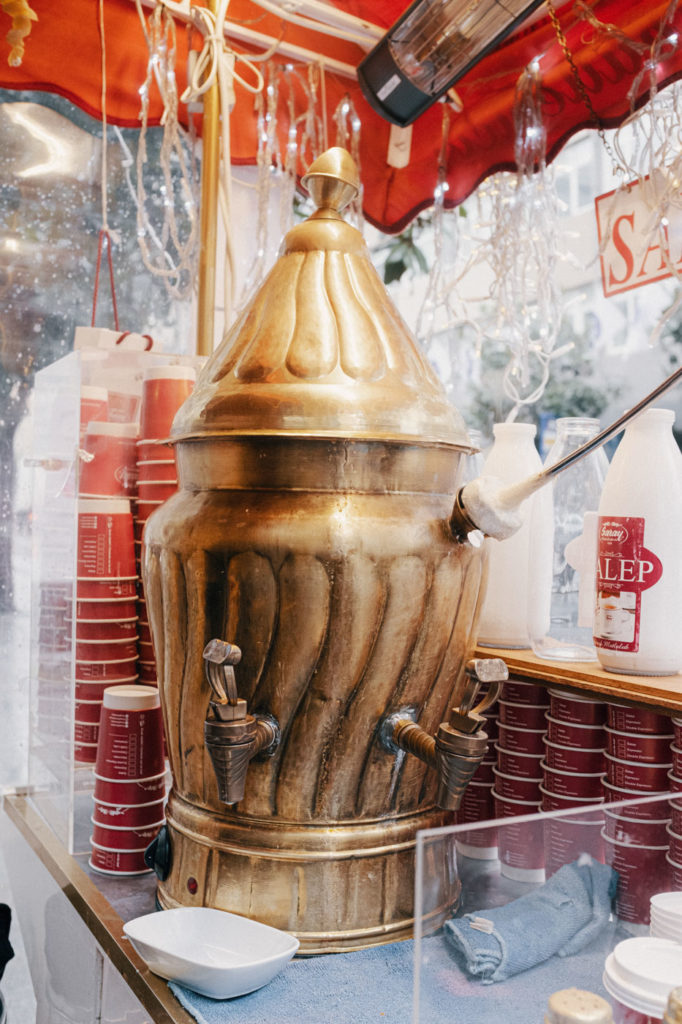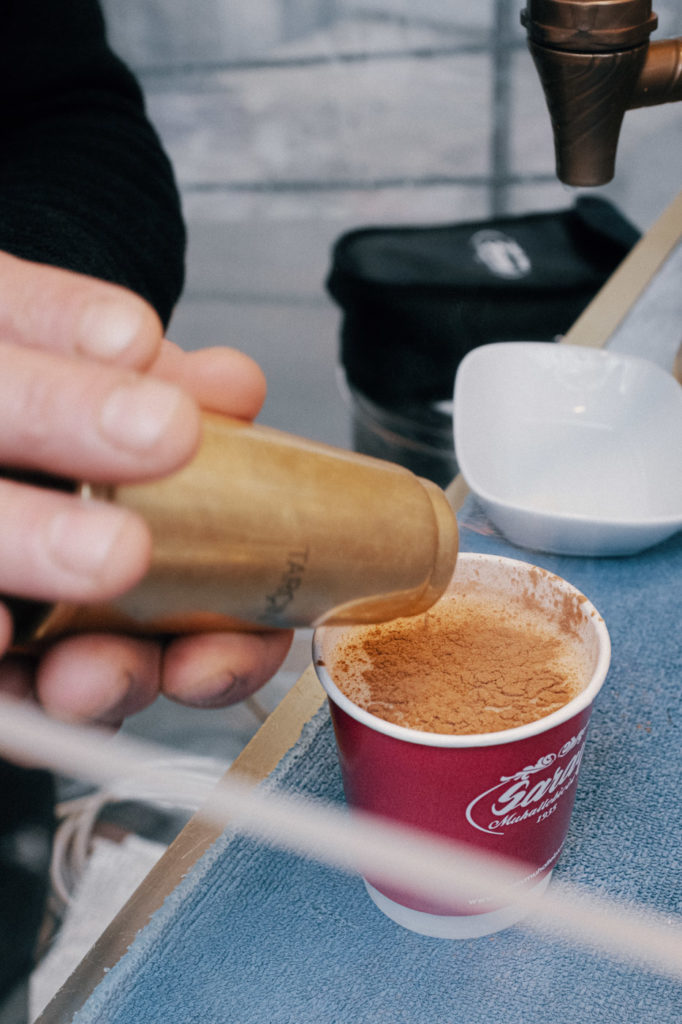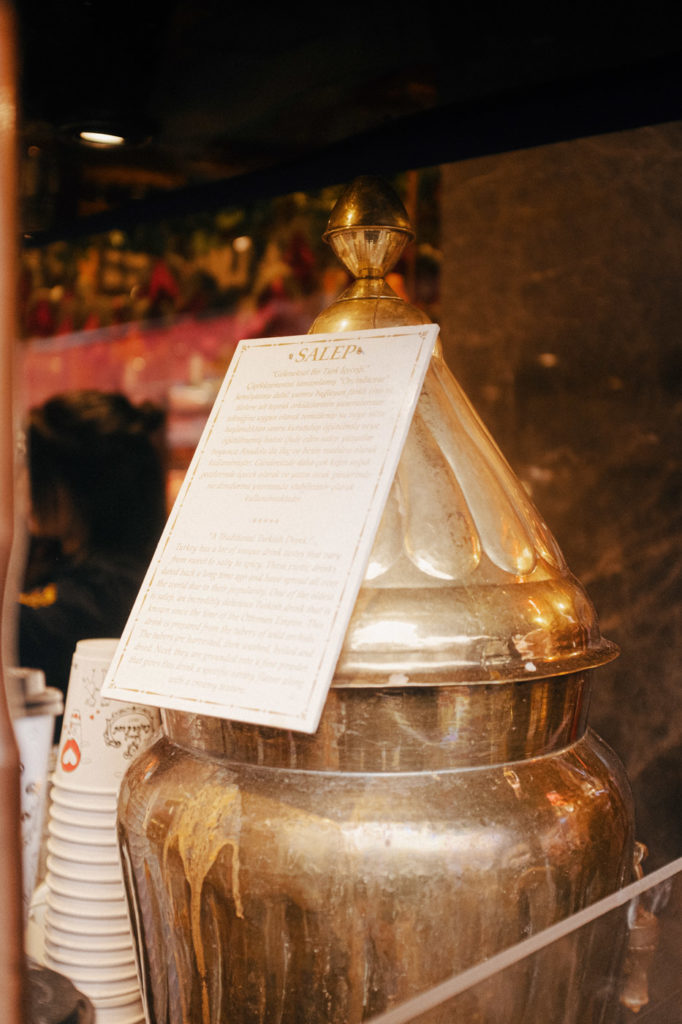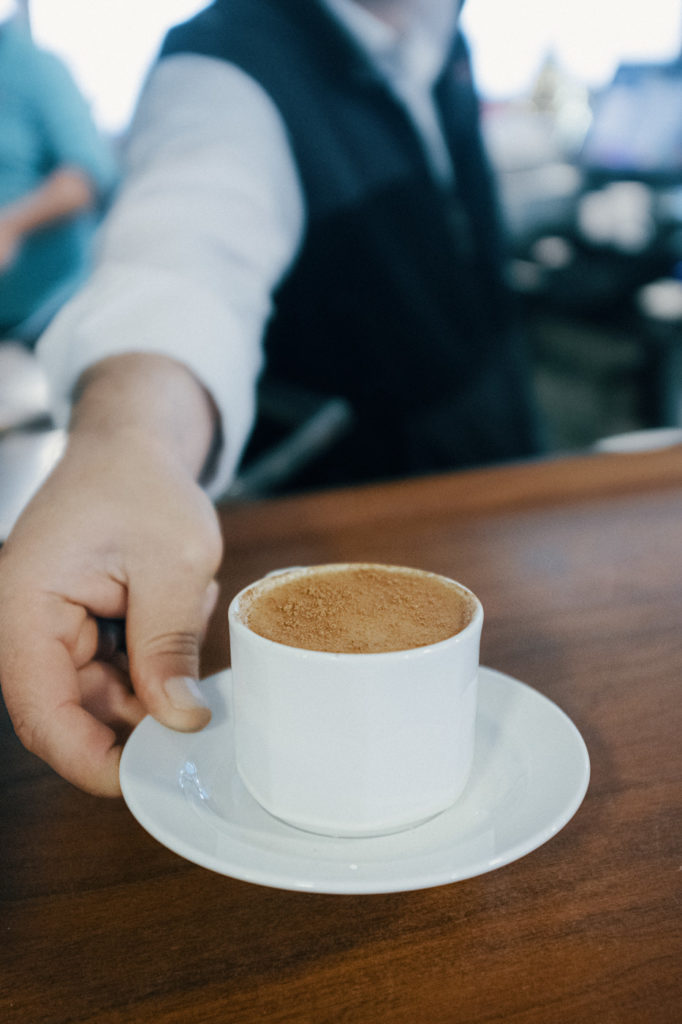It’s a typical December day in Istanbul as a growing crowd of people push through the turnstiles at the Beşiktaş-Kadıköy ferry terminal. Outside, a steady drizzle of icy rain coats the ground. For once, I don’t mind being stuck in the middle of the crowd, pressed between the damp wool coats of a half dozen strangers.
The last of the arriving passengers disembark and we slowly shuffle aboard, bottle-necking at the narrow gangplanks. I make a beeline up the stairs toward the small canteen at the back of the boat and wait my turn as the concession workers dose out black tea in paper cups, accompanied by the occasional grilled cheese sandwich. In the background, fogged-over windows obscure the view of the Sultanahmet skyline, its domes and minarets blurry like an impressionist painting.
A sign announces the recent arrival of salep, kept tongue-scalding hot in a large brass samovar. A paper cup under the nozzle catches any dribbles. I opt for a cup of the viscous beverage, steam visibly emanating from its alabaster surface.
“Cinnamon?” The concession worker asks, reaching for the shaker even before I answer affirmatively.





By the time the drink has cooled enough for me to take my first sip, we’ve almost reached our destination. The creamy, coating texture invites comparisons to eggnog, although it’s not as rich or soporific. It’s pleasantly sweet, but not overly so. The flavor, however, defies analogies.
“It’s the symbolic drink for wintertime, in Istanbul at least, if not the rest of Turkey,” says Arzu Sak Seyhun. Seyhun is the founder of the Turkish culinary magazine Gasterea. As the temperature drops, salep pops up in the most unlikely places: tea houses, pudding shops and ferries. Roaming salep vendors push large samovars on wagon-wheeled carts. He explains that the drink is typically consumed from December to February. “Once the weather starts warming up just a tiny bit, then salep is over,” she says. “It’s basically there to soothe away your winter frost. Its aroma is supposed to fill your lungs.”


___
Few tourists make it to Istanbul’s Ümraniye neighborhood. The working-class suburb is situated on the outer perimeter of the city’s Anatolian side and shares little of the charm of Istanbul’s old city. The neighborhood, however, is one of the best places to find traditional artisans working to keep Turkey’s cultural heritage alive.
Here, an anonymous proprietor of a small café speaks to me as he cooks a fresh batch of salep. Unlike the mass-produced, synthetic salep that proliferates the market, he makes salep from scratch using real ingredients. But the authenticity comes at a cost. The key ingredient of his salep has to be sourced illegally. The contraband: orchid tubers.
Traditionally, orchid tubers were thought to have medicinal value. Different ancient sources suggest the ingredient can increase fertility and breast milk production. The connection between orchids and fertility dates back to at least the first century, apparently due to the shape of the orchid tuber itself. Curiously, both the words “orchid” (of Latin origin) and “salep” (of Arabic origin) reference the orchid tuber’s resemblance to testicles.
Turkey is home to a diverse orchid fauna, including forty endemic species found nowhere else. However, due to loss of habitat, overgrazing and harvesting for salep, many of these species are now threatened. Orchids are a protected plant in Turkey. It’s illegal to export the tubers or forage for wild ones. Those caught harvesting orchids face a fine over $10,000. But on the black market, the tubers can fetch over $100 a pound. Many wild orchid tubers are foraged by shepherds who come across the plants as they graze their flocks, which makes the harvesting of wild orchids difficult to prevent.
“If you’re trying to get salep for sixteen million people, you’re obviously going to be diminishing any sources you have,” says Seyhun, referencing the official population of Istanbul.


In mass-produced versions, such as the one served on the ferry, the drink is thickened by potato starch and stabilized with xanthan gum. Salep flavoring—which consists of less than one percent of an orchid tuber—is used to give the drink aromatics. For most Turkish consumers, the flavor of artificial salep has become more familiar than the genuine article. But for connoisseurs, artificial versions are a pale imitation of real salep.
“There’s a sweetness, but there’s also this floral quality that you don’t really get with any of its substitutes,” says Seyhun. “It’s as if you were drinking perfume.”
For Umber Ahmad, founder of Mah-Ze-Dahr Bakery in Greenwich Village, New York, a family vacation to Istanbul inspired her to add salep to the seasonal menu at her bakery. “Every evening when we would come back from our day out visiting the mosques, the museums and the market, there would be somebody standing there with a huge samovar of salep,” says Ahmad. “They would pour cups for us and sprinkle some pistachios or cinnamon on top. And we would stand there in our coats, still freezing cold, and that’s how we would warm up at the end of each of our days.”
“It turned into this beautiful tradition. It wasn’t a taste profile we had ever experienced before,” she continues. The memory lingered, and Ahmad began experimenting with recipes.
“I kept on thinking I wanted to bring salep into our bakery and into the experience of our guests. We tried to find a sustainable way to bring it into our menu,” she says.
Ahmad knew the scarcity of salep’s main ingredient would be an issue, but found an unlikely solution. “There’s something called a dogstone. It’s a British equivalent of an orchid plant,” says Ahmad. “They’re very similar. It has the same level of elasticity.”
So far, the reception at Mah-Ze-Dahr has been enthusiastic. “Not one person we’ve given it to hasn’t said that they absolutely adore it,” says Ahmad. “It’s familiar, but at the same time it’s new.”
It’s a sentiment shared by Seyhun. “There’s an exoticness to it abroad, but there’s also an exoticness to it in this country as well,” she says. “It’s part of the culinary heritage of this city.”

Recipe for Salep:
Ingredients:
1 liter milk
5 grams orchid tuber flour (can substitute dogstone flour)
20 to 30 grams date sugar (or other sweetener)
Method:
Add ingredients to tea kettle or saucepan. Simmer on low heat for 12 to 15 minutes, stirring frequently to avoid scalding. Serve in mugs and garnish with cinnamon.







Our comments section is for members only.
Join today to gain exclusive access.